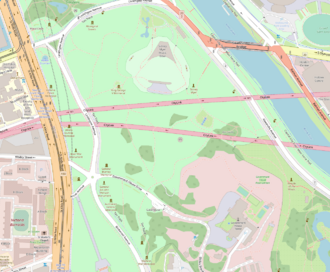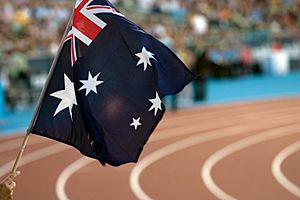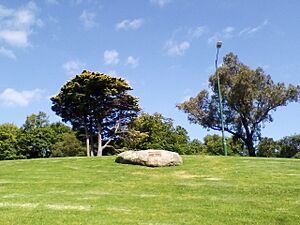Camp Sovereignty facts for kids

King's Domain Victoria
|
|
| Date | 12 March 2006 |
|---|---|
| Location | King's Domain, Victoria |
| Type | Demonstration |
| Theme | Australian Indigenous rights |
| Organized by | Marg Thorpe, Robbie Thorpe, Gary Foley, Robert Corowa |
Camp Sovereignty was an important protest by Indigenous Australians. It aimed to bring attention to a group called the "Black GST" movement. The letters "GST" stood for their main goals: stopping harm to Indigenous people, recognizing their right to self-govern, and making fair agreements with the government.
On March 12, 2006, a camp was set up in Kings Domain, a public park in Melbourne. A special ceremonial fire was lit there. This fire showed the ongoing presence of Indigenous culture in Australia. The camp also protested against the 2006 Commonwealth Games. Protesters called them the "Stolenwealth Games." This name showed their feelings about the Commonwealth and its past actions towards Indigenous Australians.
After the Commonwealth Games ended, the camp's main focus shifted to the ceremonial fire. Robert Corowa, one of the protest leaders, said the fire was sacred. This was because fire is very important in Aboriginal traditions and ceremonies.
The camp faced legal threats. Despite over 100 people protesting, the fire was put out on May 10, 2006. However, other similar fires were lit in Redfern, Dandenong, and Framlingham. These fires continued the protest's message.
Camp Sovereignty also inspired future protests. For example, the Camp Freedom rally happened on the Gold Coast during the 2018 Commonwealth Games. The events of Camp Sovereignty have also inspired new Indigenous activists and leaders. It was a notable and large-scale protest.
The protest aimed to get a lot of media attention, both in Australia and worldwide. This was to make sure people everywhere understood and thought about Indigenous Australian civil rights issues. Podcasts and documentaries have also helped to share the story and impact of the Camp Sovereignty movement.
Contents
What was the Black GST Movement?
Camp Sovereignty grew from the Australian "Black GST Movement." This group worked to end harm against Indigenous Australians (G), create their right to self-govern (S), and make agreements (T) with them. This movement started in Melbourne in early 2005. It was formed by a group known as the Black GST political group.
The Black GST group was small at first. They began sharing their message throughout 2005. They hoped to gain support before the 2006 Commonwealth Games. The Camp Sovereignty protest was organized by the Black GST group. It was led by well-known Indigenous activists. These included Marg Thorpe, Gary Foley, and Robbie Thorpe. They worked with many young local Indigenous Australian activists.
Why did the Black GST Movement protest?
The group wanted more recognition for Indigenous Australians. They protested against what they saw as unfair treatment. Here's what their "GST" ideas meant:
- G for Genocide: This referred to the mass killings of Indigenous Australians. They believed these events had been ignored by society.
- S for Sovereignty: This meant their right to self-govern. They felt Indigenous voices were silenced under Australian law. They wanted their Traditional Law to be respected.
- T for Treaties: This referred to the lack of formal agreements between the Australian government and Indigenous Australians. Activists linked these three points to ongoing land rights disagreements.
Indigenous activist Robbie Thorpe has a weekly podcast. He shares his ideas and beliefs there. In 2018, Thorpe dedicated an episode to explain the three parts of Black GST. For example, Thorpe often argued that Australia was the only Commonwealth country without an agreement with its Indigenous peoples. His podcast shares interviews and stories from the Black GST group's founders and later Indigenous activists.
How did Camp Sovereignty start?
Before Camp Sovereignty, the Black GST group shared its message. They encouraged people to join their protest. The Indigenous Law Bulletin supported Aboriginal activism in Australia. However, other media outlets did not report much on the Black GST group's plans.
As the 2006 Commonwealth Games were about to open on March 15, 2006, the group began setting up tents. Crowds gathered for the event. Camp Sovereignty officially started on March 12, 2006. With tents, a strong group, and several fires, it became clear they planned to stay. As the protest continued, the group faced criticism from the public and some other Indigenous activists. They also received legal threats from the government. Eventually, the camp was shut down.
Why was Kings Domain important?
The main protest site at Kings Domain was chosen for a special reason. In this park, Indigenous Australians honor the Kings Domain Resting Place. This site is dedicated to deceased Victorian Indigenous Australians. Protesters argued that this sacred site had been damaged by different groups. So, the group chose Kings Domain as the central protest spot. It was a symbol of past mistreatment and disrespect.
What inspired Camp Sovereignty?
The Camp Sovereignty protest at the Commonwealth Games was similar to other protests where sports and politics meet. Protests like the Brisbane 1982 Commonwealth Games protest and Sydney's 1988 Bicentennial Marches were similar. These earlier events may have inspired Camp Sovereignty to use a major Australian sporting event for their protest.



